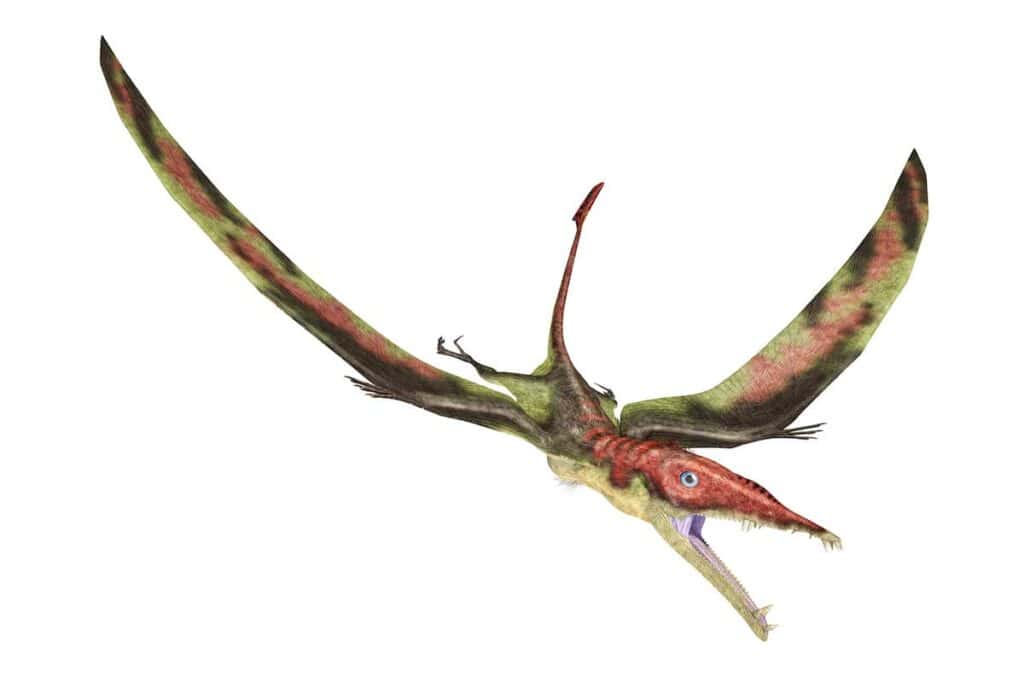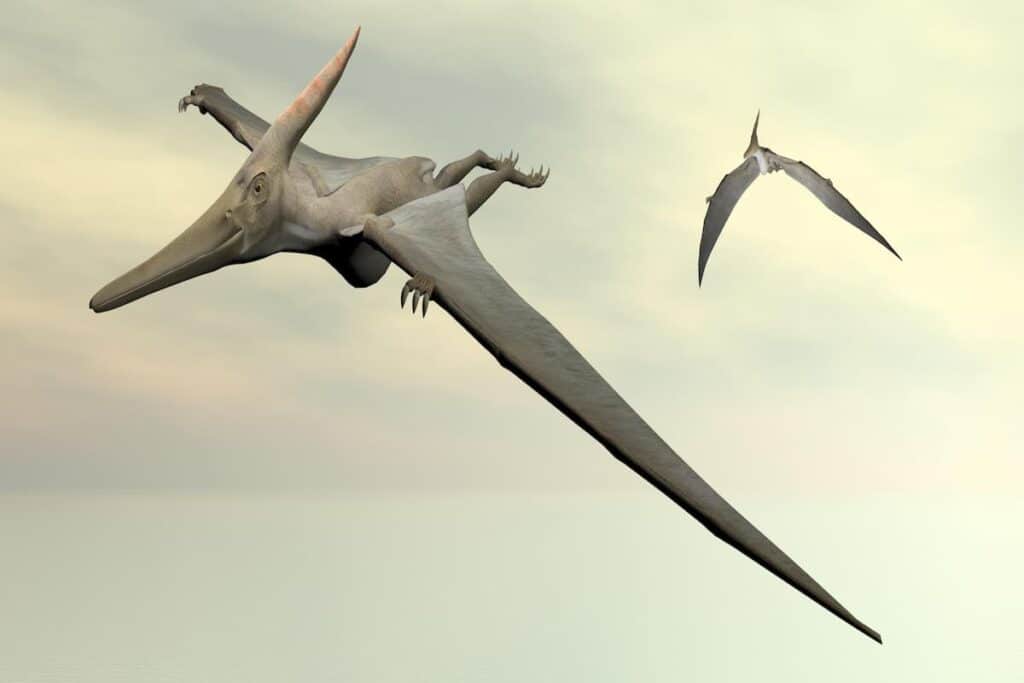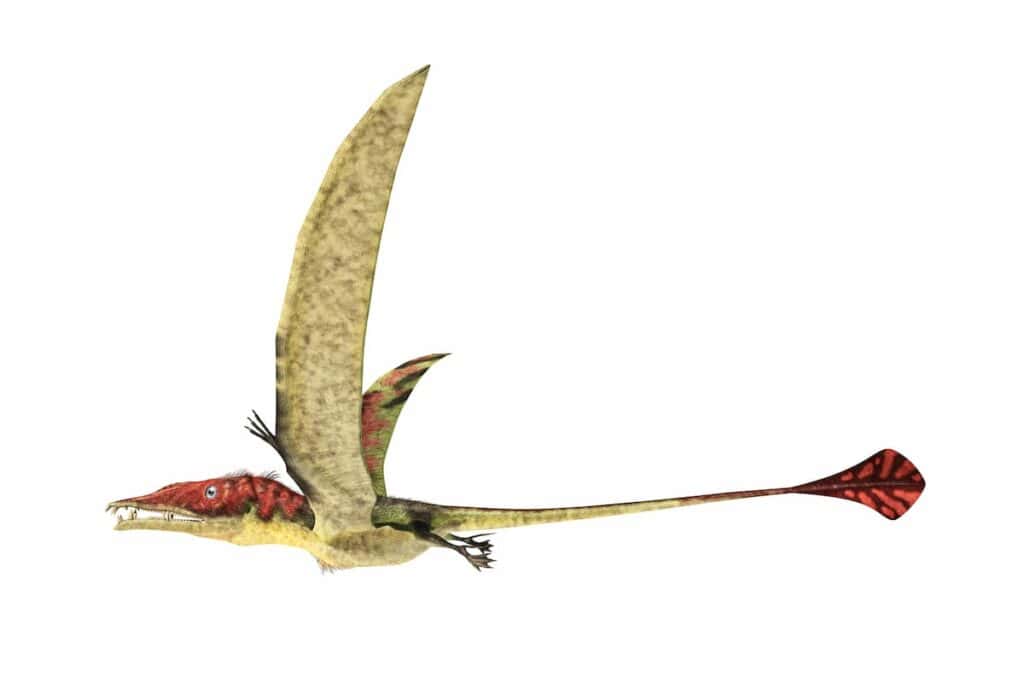Technically, no flying dinosaurs exist, but rather, there were flying reptiles that didn’t quite meet the classification of dinosaurs or birds. These creatures are known as pterosaurs. Precisely how many recognized pterosaur species currently exist?

How Many Types of Flying Dinosaurs Are There?
As of 2022, there are more than 130 pterosaur species, with new ones being located all the time. For example, in 2020, four pterosaur fossils were recovered, including the Aftotapejara zouhri.
The Mesozoic Era saw the flourishing of flying dinosaurs, among them the Pterodactyls. The Pterodactyls were known for their enormous wings and extended beaks. Equally notable was the Pteranodon, distinguished by its considerable size and crested head.
The Quetzalcoatlus too left its mark on this era, recognized as one of the largest known flying dinosaurs, its wingspan stretched to an astounding 10 meters. The fossil records, a critical tool for paleontology, from the Jurassic and Cretaceous periods, revealed a diverse range of flying dinosaurs species like the toothed Ludodactylus and Hatzegopteryx, famous for their large skulls.
Table of Contents
In the massive family of Pterosauria, dinosaurs ranged from the small Rhamphorhynchus to the large Quetzalcoatlus. The unique contributions of these creatures to the ecosystem during the Mesozoic Era went beyond their size and physical characteristics: the Archaeopteryx, for example, is considered a key link between reptiles and birds.
Finally, we have the Tapuiasaurus, although not as famous as some, its long neck and small head make it another interesting entry in the roster of Mesozoic flying dinosaurs. This era of our planet’s history was filled with a diverse range of these flying reptiles, and their legacy continues to captivate us today.
This guide to pterosaurs and their fossils will provide you with lots of information to help you appreciate these flying creatures even more. You won’t want to miss it, so keep reading!
Classification and Phylogeny – How Many Pterosaur Species Are There?
A pterosaur belongs to the clade Pterosauria. We are certain of that, but how to classify them has been largely argued over the years.
David Unwin came up with one classification system for pterosaurs in 2003 that included basal archosauromorphs as pterosaurs based on research that was available at the time. After all, the Sharovipteryx had hindlimbs featuring skin membranes that likely would have allowed it to at least glide if not fly.
Alexander Wilhelm Armin Kellner, one of the paleontologists to develop the term for pterosaur fibers (which are pycnofibers), also had his own classification for pterosaurs. In the matrix are what are recognized today as 39 species.
In 2010, Brian Blake Andres updated the classification again. He had written a dissertation on dinosaur phylogeny. He took parts of Kellner’s 2003 classification and the updates Kellner did in 2004 and other classifications between 2005 and 2009, although not by Kellner.
Unwin’s work was also accounted for, as was Andres’ own prior pterosaur classifications from 2005, 2008, and 2010. Working with Timothy Myers, the classification was published in 2013. As of current, 100 valid species of pterosaurs are included. (Source)
Based on Andres and Myers’ classification of pterosaurs, a cladogram or family tree of pterosaurs was compiled in 2018.
As you’ll recall, we have more than 130 unique pterosaur species as of 2022, so not all the species have been included in the most recent classifications.

Where Were They Found? Key Fossil Deposits of Pterosaur Dinosaur Fossils
It’s a wonder we know as much about pterosaurs as we do consider how hard their fossils are to come by. The bones of pterosaurs were generally light and often hollow to allow for flight capabilities, which means they didn’t hold up particularly well over time. Finding a whole skeleton is especially rare.
Keeping that in mind, let’s go over the multitude of notable locations around the world where pterosaur fossils have been found.
Solnhofen Limestone
Bavaria’s Solnhofen Plattenkalk or Solnhofen Limestone is a Lagerstatte, which refers to sedimentary deposits that preserved dinosaur fossils well, even down to the soft tissue at times.
Jurassic-era fossils have been recovered here, including pterosaurs, marine reptiles, and even an Archaeopteryx specimen, which is a species we talked about in another recent blog post.
The Pterodactylus is one pterosaur genus found in this area, including fossils for what would become the only identified species, the Pterodactylus antiquus.
This species holds a special place in the world of pterosaurs because it was the first of its kind to be correctly identified as a flying reptile rather than a dinosaur. The carnivorous dinosaur consumed vertebrates and invertebrates alike.
The wingspan of the Pterodactylus antiquus would have been under four feet, but this is just an estimate. The flying reptile had almost 100 teeth in its long skull, some conical and others narrow.
Santana Group
In Brazil, the Santana Group is another area where a slew of pterosaurs was found in the 1970s. As part of the Araripe Basin, the Santana Group has produced many fossils over the years, everything from snakes to turtles, arthropod insects, fish, and flora. The dinosaur fossils found here include the Irritator.
As for pterosaurs, the Thalassodromeus is the most famous fossil, but other pterosaur bits and pieces have been uncovered as well.
The Thalassodromeus is believed to have lived during the Early Cretaceous Period roughly 100 million years ago. Its skull was uncovered in 1983 in the Araripe Basin. That skull later became a holotype of the Thalassodromeus sethi.

The skull of this pterosaur was massive, about five feet in length. Paleontologists don’t know for certain, but they predict the Thalassodromeus’ wingspan was up to 15 feet long. That’s right, and this dinosaur would have been able to fly despite its massive cranium. (Source)
Forni Dolostone
The Dolomia di Forni or Forni Dolostone was another pterosaur goldmine in northeastern Italy. Four identified pterosaur species were located here.
The first is the Austriadactylus. This rhamphorhynchoid pterosaur was mostly recovered in Austria, with some remains in the Forni Dolostone. As a long-headed dinosaur, the Austriadactylus had a beak-like snout. Its wingspan would have been about 48 inches.
The Preondactylus was uncovered fully in the Italian Forni Dolostone in the 1980s. Believed to have lived during the Late Triassic Period, there is but one identified species, the Preondactylus buffarinii.
The Seazzadactylus from the Triassic Period was predicted by experts to have lived in today’s Italy, which explains its remains being uncovered where they were among the Dolostone. The sole identified species is the Seazzadactylus venieri, with “dactylus” coming from the Greek term for finger, daktylos.
Niobrara Formation
Kansas’ Niobrara Formation or Niobrara Chalk is yet a third location where many pterosaurs have been found. The fossils here date back 82 to 87 million years to the Late Cretaceous Period.
The Niobrara Formation has two units, the Fort Hays Limestone Member and the Smoky Hill Chalk Member. Pterosaur, mosasaur, and plesiosaur fossils and specimens have been found in the Formation.
One such pterosaur unearthed in this area is the Nyctosaurus or the night lizard. This Late Cretaceous creature lived near the shoreline and has been likened to today’s albatross. According to experts, the Nyctosaurus had a 6.5 and 13 feet wingspan.

What Were Some of the Special Features of Pterosaurs and Which One Was the Biggest?
Pterosaurs are fascinating because they don’t quite fit into the box of dinosaurs or birds. They’re unique in that they had features not found in other species that lived in their age. Let’s look at these features, as the overview will help us determine which was the largest pterosaur.
Crests
Cranial crests were common in pterosaurs. Horn-like and certainly comprised of bone, the crests remained through to the Late Cretaceous pterosaurs, proving that the crests came in handy. Otherwise, they would have been evolutionarily phased out.
The shapes and sizes of a pterosaur’s crest ran the gamut. The Nyctosaurus, as mentioned earlier, had a fan-shaped crest nearer the back of its head. The Pteranodon longiceps featured blade-like crests, and the Pteranodon sternbergi had a tall, straight head crest.
Why the crests in the first place? Experts aren’t precisely sure what function they served, but the crests could have helped stabilize a pterosaur when it hunted for food in the water or perhaps aided the pterosaur in flight.
Crests might have allowed for heat regulation or even acted as a trait when choosing a mate. In that case, crests would have been like showy peacock feathers long before peacocks existed!
Hollow Bones
It goes back to what we discussed before. Likely to keep them lightweight enough for flight, pterosaurs had hollow bones. Interestingly, their hollow bones had greater bend resistance than traditional dinosaur bones with marrow.
This bend resistance would have allowed larger pterosaurs to support themselves and stay upright.
Large Cerebellum
The brains of pterosaurs are truly interesting. Although they’re classified as flying reptiles today, pterosaurs had brains more akin to birds than reptiles. Among the reasons for this is the size of the cerebellum, which determines the rate at which muscles contract.
Thus, pterosaurs needed a more sizable cerebellum than other species because they had more muscles to regulate in their expansive wings.
Wingspan
Speaking of big things, the wingspan is certainly the determining factor in the largest pterosaur. That distinction goes to the Quetzalcoatlus, a giraffe-sized pterosaur with a wingspan measured approximately 40 feet. (Source)
Other pterosaurs come close, but none quite hit the mark!
Conclusion
Flying dinosaurs, more technically flying reptiles, are known as pterosaurs. With more than 130 identified species, pterosaurs lived across millions of years, with their fossils uncovered worldwide.
The fun thing about pterosaurs is that there’s always something new to learn about them. Hopefully, there’s another discovery soon!
